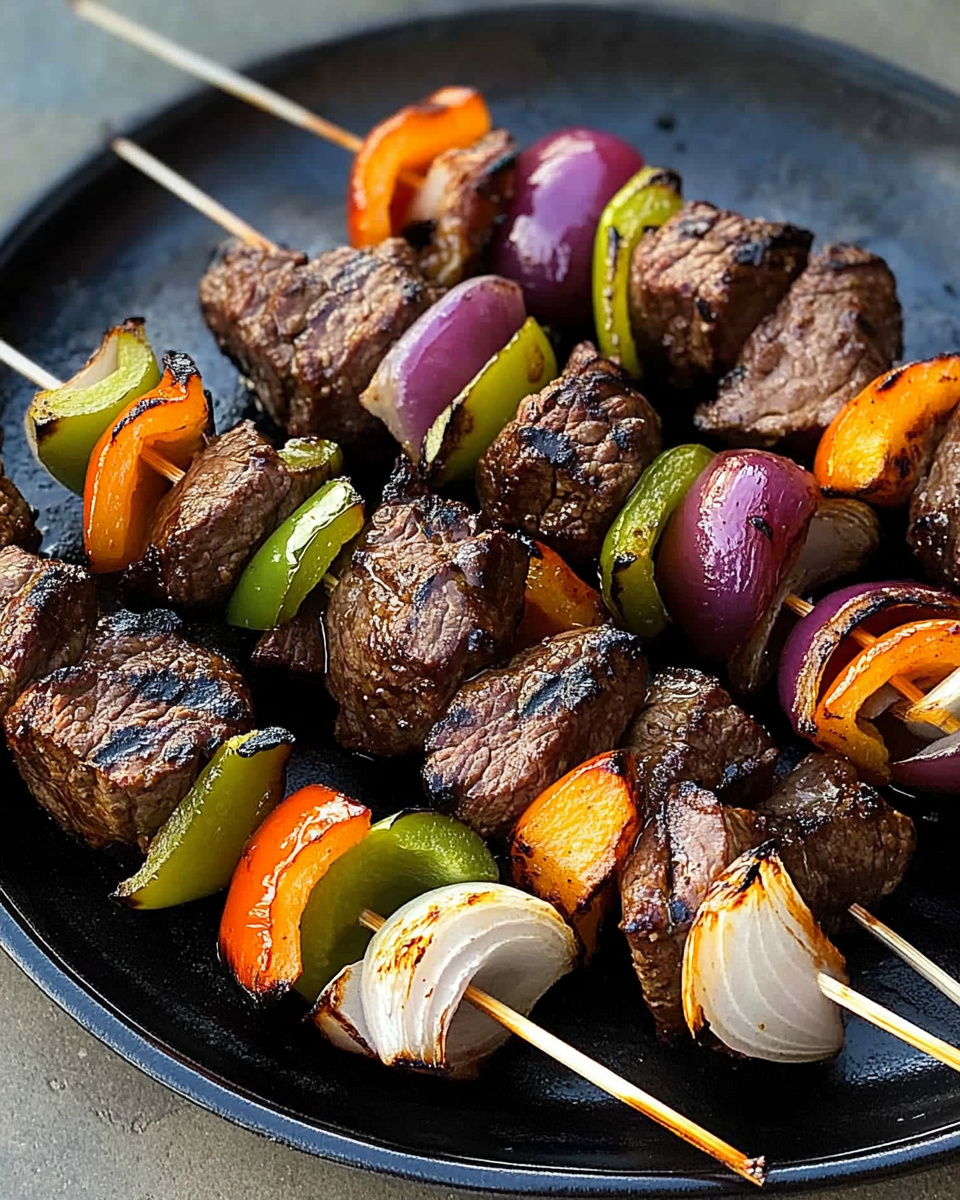A flavorful and juicy grilled pork tenderloin that’s perfect for weeknight dinners or weekend barbecues. This simple yet impressive dish features a savory marinade and a beautifully grilled exterior with tender, succulent meat inside.
FULL RECIPE
Ingredients
- 1 ½ pounds pork tenderloin, trimmed
- ¼ cup olive oil
- 3 tablespoons soy sauce
- 2 tablespoons Dijon mustard
- 2 tablespoons brown sugar
- 2 tablespoons balsamic vinegar
- 3 cloves garlic, minced
- 1 teaspoon dried rosemary
- 1 teaspoon salt
- ½ teaspoon black pepper
Directions
- In a bowl, whisk together olive oil, soy sauce, Dijon mustard, brown sugar, balsamic vinegar, garlic, rosemary, salt, and pepper.
- Place pork tenderloin in a resealable plastic bag or shallow dish and pour marinade over it.
- Seal or cover and refrigerate for at least 2 hours, preferably overnight, turning occasionally.
- Preheat grill to medium-high heat.
- Remove pork from marinade and let excess drip off.
- Grill pork for 15–20 minutes, turning every 4–5 minutes, until internal temperature reaches 145°F.
- Remove from grill and let rest for 5–10 minutes before slicing.
- Slice into medallions and serve.
Nutritional Information
- Calories: 280
- Protein: 28g
- Fat: 15g
- Carbohydrates: 6g
- Fiber: 0g
- Sugar: 4g
- Sodium: 600mg
Choosing the Right Cut of Pork for Grilling
Pork tenderloin is an ideal cut for grilling due to its lean texture and mild flavor. It is a long, thin muscle that runs along the backbone and is known for being tender without excess fat. Selecting fresh pork tenderloin with a pinkish color and minimal marbling ensures a juicy and flavorful end result. Avoid cuts that look dry or have discoloration to guarantee the best taste.
Marinating for Maximum Flavor
Marinating pork tenderloin is essential to infuse flavor and tenderize the meat. The combination of acidic ingredients like balsamic vinegar and soy sauce helps break down muscle fibers, making the pork more tender. Brown sugar adds a subtle sweetness that balances the savory elements, while garlic and rosemary contribute aromatic depth. Allowing the pork to marinate for at least two hours or overnight maximizes flavor penetration.
Balancing Sweet and Savory Notes
The marinade in this recipe strikes a perfect balance between sweet and savory. Brown sugar complements the tangy balsamic vinegar and salty soy sauce, creating layers of flavor. Dijon mustard adds a slight sharpness and creaminess, enhancing complexity. This balance prevents the pork from tasting too salty or overly sweet, appealing to a wide range of palates.
Importance of Proper Temperature Control
Grilling pork tenderloin at medium-high heat ensures a nicely seared exterior while keeping the inside tender and juicy. Cooking too fast at high heat risks drying out the meat, while too low heat might result in uneven cooking. Monitoring the internal temperature with a meat thermometer is crucial; 145°F is the recommended safe temperature that retains moisture.
Resting the Meat After Grilling
Allowing the pork to rest after grilling is a critical step often overlooked. Resting lets the juices redistribute throughout the meat, preventing them from spilling out when slicing. This results in a moister and more flavorful dish. A rest time of 5 to 10 minutes is sufficient for pork tenderloin.
Grilling Techniques and Tips
For even cooking, rotate the tenderloin regularly on the grill. Using direct heat for searing and indirect heat for finishing can help control doneness. To add extra smoky flavor, consider using wood chips or charcoal rather than gas grills. Always clean and oil grill grates before cooking to prevent sticking.
Health Benefits of Pork Tenderloin
Pork tenderloin is a lean protein source rich in essential nutrients like B vitamins, zinc, and iron. It provides muscle-building amino acids while being relatively low in fat compared to other pork cuts. When grilled with a marinade like this recipe uses, it offers a balanced meal option without excess calories or unhealthy fats.
Pairing Ideas to Complement the Dish
Grilled pork tenderloin pairs wonderfully with fresh, vibrant sides such as roasted vegetables, garlic mashed potatoes, or a crisp salad. Fruit-based salsas or chutneys, like mango or apple, add a refreshing contrast to the smoky pork. Light grains such as quinoa or couscous also work well for a complete meal.
Adjusting Marinade Ingredients for Dietary Needs
The marinade can be modified for dietary preferences. For a lower sodium option, reduce soy sauce or substitute with coconut aminos. Those avoiding sugar can swap brown sugar with natural sweeteners like honey or maple syrup in moderation. The recipe is naturally gluten-free but ensure all marinade ingredients comply with dietary restrictions.
Using Fresh vs. Dried Herbs
Rosemary in this recipe provides a piney, aromatic flavor that complements pork. Fresh herbs can be used in place of dried for a brighter taste, though dried herbs are more concentrated. When substituting, use about three times the amount of fresh herbs compared to dried to maintain flavor intensity.
Common Mistakes to Avoid
Overcooking pork tenderloin is the most frequent error, leading to dry, tough meat. Using a thermometer is the best way to avoid this. Another mistake is insufficient marinating time, which can result in bland flavor. Avoid rushing the process to allow proper flavor infusion.
How to Slice Pork Tenderloin
Slicing against the grain is key to tender bites. The grain refers to the direction of muscle fibers; cutting perpendicular shortens them, making the pork easier to chew. Slice pork tenderloin into medallions roughly ½ inch thick for ideal serving portions.
Storing and Reheating Leftovers
Leftover grilled pork tenderloin should be cooled and stored in an airtight container in the refrigerator for up to 3 days. To reheat, warm gently in the oven or microwave to avoid drying out. Using leftovers in salads, sandwiches, or stir-fries is a tasty way to reduce waste.
Cooking for Different Group Sizes
This recipe serves about four but can be easily doubled or halved depending on the number of guests. When scaling up, marinate the pork in larger containers or bags to ensure even coverage. Cooking times remain similar but always check internal temperature.
Alternative Cooking Methods
If a grill is unavailable, pork tenderloin can be cooked in the oven or on a stovetop skillet. Roasting at 400°F for about 20–25 minutes or searing then finishing in the oven produces similar results. A cast-iron skillet helps develop a caramelized crust.
Wine Pairings
Light to medium-bodied red wines like Pinot Noir or Zinfandel complement the grilled pork’s flavor profile. For white wine lovers, an oaked Chardonnay or a dry Riesling pairs nicely, balancing the marinade’s sweet and tangy notes.
Serving Suggestions for Presentation
Serving the pork sliced on a wooden board with fresh herbs garnishing the plate adds rustic charm. Drizzling extra marinade reduction or a light pan sauce over the pork elevates the presentation and flavor. Pair with colorful vegetables for a visually appealing meal.
Cultural Variations and Influences
Grilled pork tenderloin is popular in various cuisines, each adding its unique twist. Asian styles might incorporate soy sauce and ginger, Mediterranean versions include herbs like oregano and lemon, while Latin recipes use spices such as cumin and chili. This recipe blends sweet, savory, and tangy elements common in Western grilling traditions.
Seasonal Variations
This recipe works year-round but can be adapted seasonally. Summer grilling with fresh herbs from the garden or autumn pairings with roasted root vegetables creates a seasonal dining experience. Adding citrus zest in spring brightens the marinade.
Environmental Considerations
Choosing pork from sustainable farms that prioritize animal welfare and environmental care supports ethical consumption. Local sourcing reduces carbon footprint and often ensures fresher meat. Grilling outdoors also minimizes indoor energy use compared to oven cooking.
Conclusion
Grilled pork tenderloin is a versatile and crowd-pleasing dish that combines simplicity with bold flavors. Its lean, tender texture makes it a healthy protein choice, while the balanced marinade elevates its taste profile. Mastering the techniques of marinating, grilling, and resting guarantees juicy results every time. Whether served for a casual dinner or special occasion, this recipe offers a delicious and satisfying meal that is easy to prepare and customize. With thoughtful pairings and proper cooking, grilled pork tenderloin can become a go-to favorite in any kitchen.






